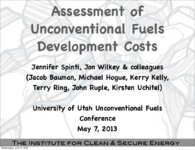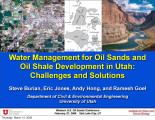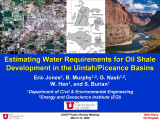TO
Filters: Collection: "ir_eua"
| Title | Date | Subject | Description | ||
|---|---|---|---|---|---|
| 226 |
 |
Underground coal thermal treatment - Task 6 topical report, Utah Clean Coal Program | 2015-01 | transformational energy production; insitu thermal treatment of a coal seam; coal reserves; underground coal thermal treatment; Utah Clean Coal Program; coal resources | The long-term objective of this task is to develop a transformational energy production technology by in situ thermal treatment of a coal seam for the production of substitute natural gas and/or liquid transportation fuels while leaving much of the coal's carbon in the ground. This process converts ... |
| 227 |
 |
Assessment of unconventional fuels development costs | 2013-05-07 | ICSE; Unconventional fuels; Development cost; Oil Shale; In situ; Ex situ; Oil Sands; Utah; Uinta Basin | Presentation given at the University of Utah Unconventional Fuels Conference, Salt Lake City, Utah, May 7, 2013. |
| 228 |
 |
APPENDIX D - Meeting data needs to perform a water impact assessment for oil shale development in the Uinta and Piceance Basins, A subpart of project - Quantifying water availability impacts and protecting water quality while developing Utah oil shale and sands - Final Project Report - Reporting period: June 21, 2006 to October 21, 2009 | 2009-06-23 | Uinta Basin; Piceance Basins; Water impact assessments; Oil shale development | The goal of this project was to mitigate water resources impacts from oil shale development in the U.S. by compiling geospatial data and water use estimates to assess water availability impacts. |
| 229 |
 |
A model of hydrocarbon generation from type 1 kerogen: Application to the Uinta Basin, Utah | 1986-12-18 | Pyrolysis; Green River shale; Petroleum; Utah; Uinta Basin; Kerogen; Oil; Eocene; Type I kerogen; Hydrocarbon generation; Oil generation; Gas generation; Kinetics | The Uinta Basin in northeastern Utah provides an ideal setting to study the evolution of kerogen to petroleum. Oil shale rocks of the Eocene-age Green River Formation outcrop extensively at the southern edge of the synclinal basin. The same rocks are also found at depths of 3650 m in the deepest par... |
| 230 |
 |
Apparatus and method for recovery of bituminous products from tar sands | 1978-06-20 | An apparatus and method for (1) reducing agglomerated masses of tar sand and (2) recovering as a bituminous product the bituminous matrix material therefrom. The apparatus includes a vessel which is divided into an attrition zone enclosed by a screen member, a sand separation zone and a product reco... | |
| 231 |
 |
Oil-impregnated sandstone deposits Circle Cliffs Uplift, Utah | 1981-04 | oil-impregnated sandstone; Utah deposits; Circle Cliffs Uplift; Triassic Moenkopi Formation; oil-impregnated sandstone resource | One of the major oil-impregnated sandstone deposits in the United States is present on the Circle Cliffs uplift in an unnamed sandstone unit in the middle portion of the Triassic Moenkopi Formation. The deposit occurs on the west and east flanks of the uplift and is separated by an irregular barren ... |
| 232 |
 |
Recovery of heavy crude oil or tar sand oil or bitumen from underground formations | 1992-09-08 | heavy crude oil; tar sand oil; bitumen; oil recovery; patent; underground formations | Heavy crude oil or tar sand oil or bitumen is recovered from an underground formation containing the same by introducing into said formation via an injection well or conduit a hot alkaline aqueous fluid so as to bring about the movement or migration or stripping of said heavy crude oil or tar sand o... |
| 233 |
 |
Chapter 24 | |||
| 234 |
 |
Method and apparatus for recovering viscous petroleum from tar sand | 1981-02-03 | patent; viscous petroleum recovery; tar sand; recovering viscous petroleum from tar sand; deviated steam injection well; pumping wells; fluidized petroleum recovery | A method of recovering viscous petroleum from tar sand formations utilizing a deviated steam injection well with pump-down (through the flow line) completion. The steam injection well may use side pocket mandrels with constant flow or orifice regulators to control steam injection rates into the surr... |
| 235 |
 |
Petrologic aspects of some bitumen-bearing sandstones from Sunnyside, Utah | 1986 | bitumen sandstones; Ecocene rocks | Sandstones from the bitumen deposit near Sunnyside, Utah, exhibit many diagenetic modifications that should be considered in any attempt to recover the bitumen. The sandstones generally are subfeldspathic to feldspathic arenites, with varying amounts of carbonate lithic fragments. Detrital feldspars... |
| 236 |
 |
Water management for oil sand and oil shale development in Utah: Challenges and solutions | 2009-02-27 | water management; oil sands; oil shale; integrated water management | Analysis of the water management and impact issues relevant to oil sands and oil shale development in Utah, presented at the 2009 Western U.S. Oil Sands Conference by Steve Burian, Assistant Professor, Department of Civil and Environmental Engineering, University of Utah |
| 237 |
 |
Environmental, health, safety, and socioeconomic impacts associated with oil recovery from tar-sand deposits in the United States | 1981-09-12 | tar sand; tar sand resources; oil recovery; petroleum extraction | The tar-sand resources of the United States have the potential to yield as much as 36 billion barrels (bbls) of oil. The tar-sand petroleum-extraction technologies now being considered for commercialization in the United States include both surface (above-ground) systems and in situ (underground) pr... |
| 238 |
 |
Tar-sand resources of the Uinta Basin, Utah: A catalog of deposits | 1996-05 | tar sand; oil-impregnated sandstone; tar sand resources; solid hydrocarbon deposits; bitumous sandstone | Tar-sand, or oil-impregnated sandstone, deposits and occurrences of the Uinta Basin, Utah are summarized and presented. Twenty five tar-sand deposits/occurrences are reviewed with respect to geology, locations of bitumen saturated outcrops, land ownership, physiography, bitumen-analyses, development... |
| 239 |
 |
A sulfur isotopic study of Uinta Basin hydrocarbons | 1973 | Sulfur isotope analyses of tar from oilimpregnated sandstones, crude oils and solid hydrocarbons from the Uinta Basin (Tertiary), Utah, show wide variations, but all are heavier than the troilite sulfur isotopic standard. The data range from +2.7 to 30.3 permil and sulfur contents are low, usually l... | |
| 240 |
 |
Clean and secure energy from coal, oil shale, and oil sands: Quarterly progress report: October 1, 2008 to December 31, 2008 | 2008-01-31 | CASE; Energy development; Electric power generation; Liquid transportation fuels; Coal; Oil sands; Oil shale; Clean Coal Program; Oil Shale and Sands Program; OSSP; Policy Environment, and Economics Program; PEEP; CO2 capture; sequestration; Chemical looping combustion; CLC; Ash-partitioning; PIV; P... | The University of Utah Clean and Secure Energy (CASE) project is pursuing interdisciplinary, cradle-to-grave research and development of energy for electric power generation and for liquid transportation fuels from the abundant domestic resources of coal, oil sands, and oil shale. It's work is divid... |
| 241 |
 |
Estimating water requirements of oil shale development in the Uintah/Piceance Basins | 2008-03-12 | water requirements; oil shale development; water resources; oil sands | Collect geospatial data and information on water resources associated information related to oil sands and oil shale development -Conduct a regional analysis of water requirements for oil shale development incorporation urbanization, alternative energy development, and wastewater recycling/reuse -De... |
| 242 |
 |
Method of separating bitumen from tar sand with cold solvent | 1976-11-23 | Bitumen; Tar sand; Separation; Solvent extraction; Cold solvent | A method for separating bitumen from tar sand by solvent extraction with efficient separation of water from the recovered bitumen is disclosed. Tar sand may often be recovered by surface mining techniques. The tar sand is comprised of bitumen, water and sand including clays. The tar sand is contacte... |
| 243 |
 |
A technical, economic, and legal assessment of North American heavy oil, oil sands, and oil shale resources: In response to Energy Policy Act of 2005 Section 369(p) | 2007-09 | Oil sands; Oil shale; Heavy oil; Energy Policy Act; 2005; Climate Change; Petroleum; Oil Cost; United States; North American heavy oil; Utah Heavy Oil Program; UHOP; World economic development; Energy; Canadian oil sands; Unconventional resources ;Technical; Economic; Legal assessment | Against the backdrop of world population growth, rapid economic expansion in the world's most populous countries, challenging political climates in many oil-producing nations, and the specter of climate change, worldwide energy consumption is projected to increase from the 2004 level of just over 40... |
| 244 |
 |
Technology of the recovery of values from tar sands | 1982-08 | recovery of values; tar sand; bitumen recovery; in situ processes; thermal recovery methods; COFCAW; combination of forward combustion and water flood process; emulsion-steam drive process; nuclear stimulation; mining; processing mined tar sands; anhydrous solvent extraction process; cold water sepa... | There are two basic approaches to recovering bitumen. The tar sand may be mined and transported to a process plant where the bitumen is extracted and the sand is discharged. Alternatively the separation of bitumen from sand may be accomplished without ever moving the sand, that is, in situ. In situ ... |
| 245 |
 |
Development of CFD-based simulation tools for in situ thermal processing of oil shale/sands | 2012-02 | CFD; in situ; in situ thermal processing; oil shale; oil sands | In our research, we are taking the novel approach of developing and applying high performance computing, computational fluid dynamics (CFD)-based simulation tools to a modified in-situ process for production of oil from oil shale. The simulation tools being developed capture the relevant physical pr... |
| 246 |
 |
Water availability for development of major tar sands areas in Utah | 1979-05 | water availability; major tar sands area; development of tar sands; tar sands deposits; water requirements; water availability | The Sutron Corporation, under contract with Colorado State University, has conducted a study for the Laramie Energy Technology Center (LETC) to determine the availability of water for future extraction of viscous petroleum (bitumen) from the six major tar sands deposits in Utah. Specifically the are... |
| 247 |
 |
Carbon dioxide sequestration: Effect of the presence of sulfur dioxide on the mineralogical reactions and on the injectivity of CO2+SO2 mixtures | 2010-01 | Carbon dioxide sequestration; CO2; Sequestration stream; Gas injection; CO2+SO2 mixture; Brine; Arkose; Calcite; Anhydrite; Calcium carbonate; CaCO3; Ankerite; Absolute permeabilities; Free-gas; Dissolved gas distribution; Saline formation; Contaminant gases; sulfur dioxide; SO2; Hydrogen sulfide; H... | This report presents experimental and modeling data on certain aspects of carbon dioxide (CO2) sequestration. As different processes are developed and implemented to facilitate the capture of CO2, other contaminant gases (sulfur dioxide, hydrogen sulfide and ammonia) may be present in the sequestrat... |
| 248 |
 |
Oil-impregnated sandstone mapping project Nine Mile Canyon area Carbon and Duchesne Counties, Utah: A field examination for the Utah Geological Survey | 1971-10-04 | Tributaries; Nine Mile canyon; Argyle canyon; Uinta Basin; Deltaic facies; Green River Formation; Parachute Creek | A reconnaissance survey of tributaries to Nine Mile and Argyle canyons in the southern Uinta Basin showed widespread but erratic distribution of oil-impregnated sandstones. The occurrences are mainly in the Deltaic facies of the Green River formation. The bituminous material is believed to have been... |
| 249 |
 |
Oil-impregnated sandstones of Raven Ridge, Vernal, Utah | 1972 | Oil-impregnated sandstone; Raven Ridge; Vernal, Utah; Uinta Basin; Utah; Colorado; Wasatch Formation; Green River Formation; Uinta Formation | The area of this report is in the northeastern part of the Uinta Basin of northeastern Utah and northwestern Colorado. The area covers approximately 52 square miles of what is regionally called Raven Ridge. Raven Ridge, a series of hogback ridges, trends northwest-southeast, and includes three Eocen... |
| 250 |
 |
Naval petroleum and oil shale reserves | 1996 | Naval Petroleum Reserve; Oil shale reserves; California; Wyoming; Utah; Colorado; Naval Petroleum Reserves Production Act of 1976; Annual Report; 1996 fiscal year | During fiscal year 1996, the Department of Energy continued to operate Naval Petroleum Reserve No. 1 in California and Naval Petroleum Reserve No. 3 in Wyoming through its contractors. In addition, natural gas operations were conducted at Naval Petroleum Reserve No. 3. All productive acreage owned b... |
